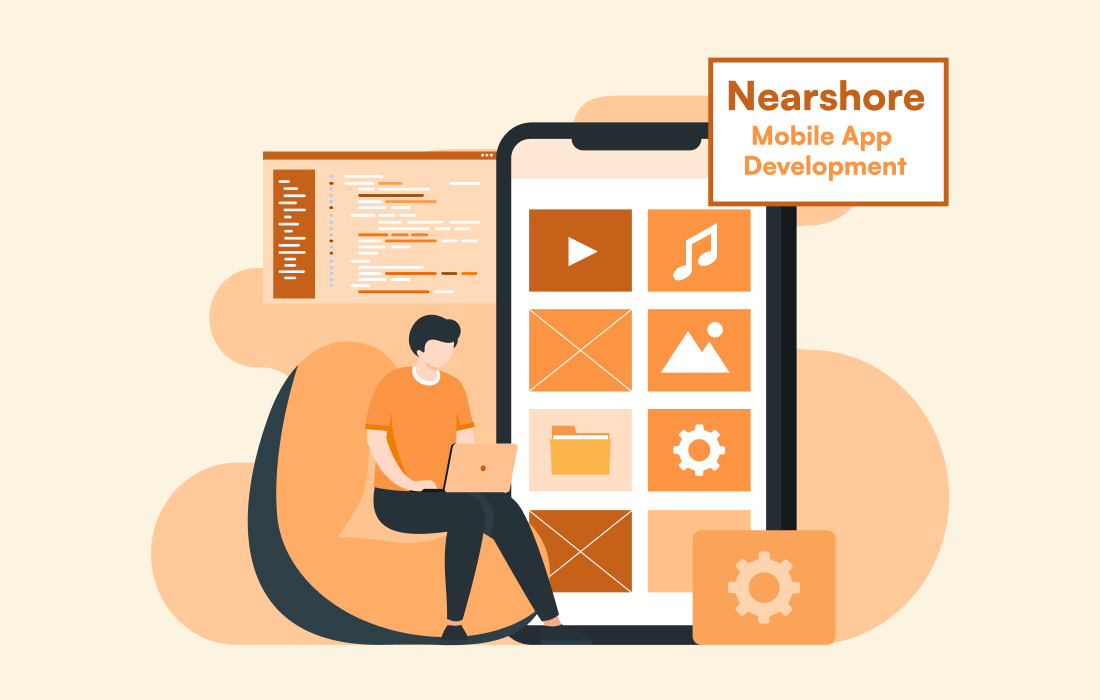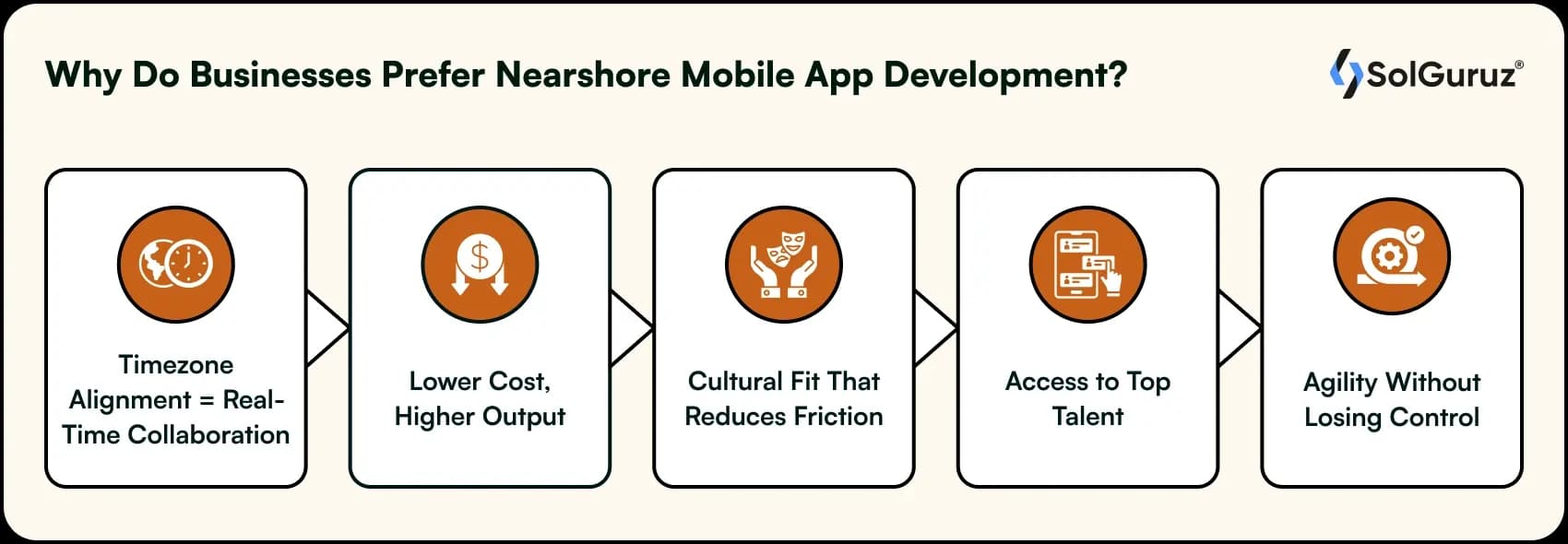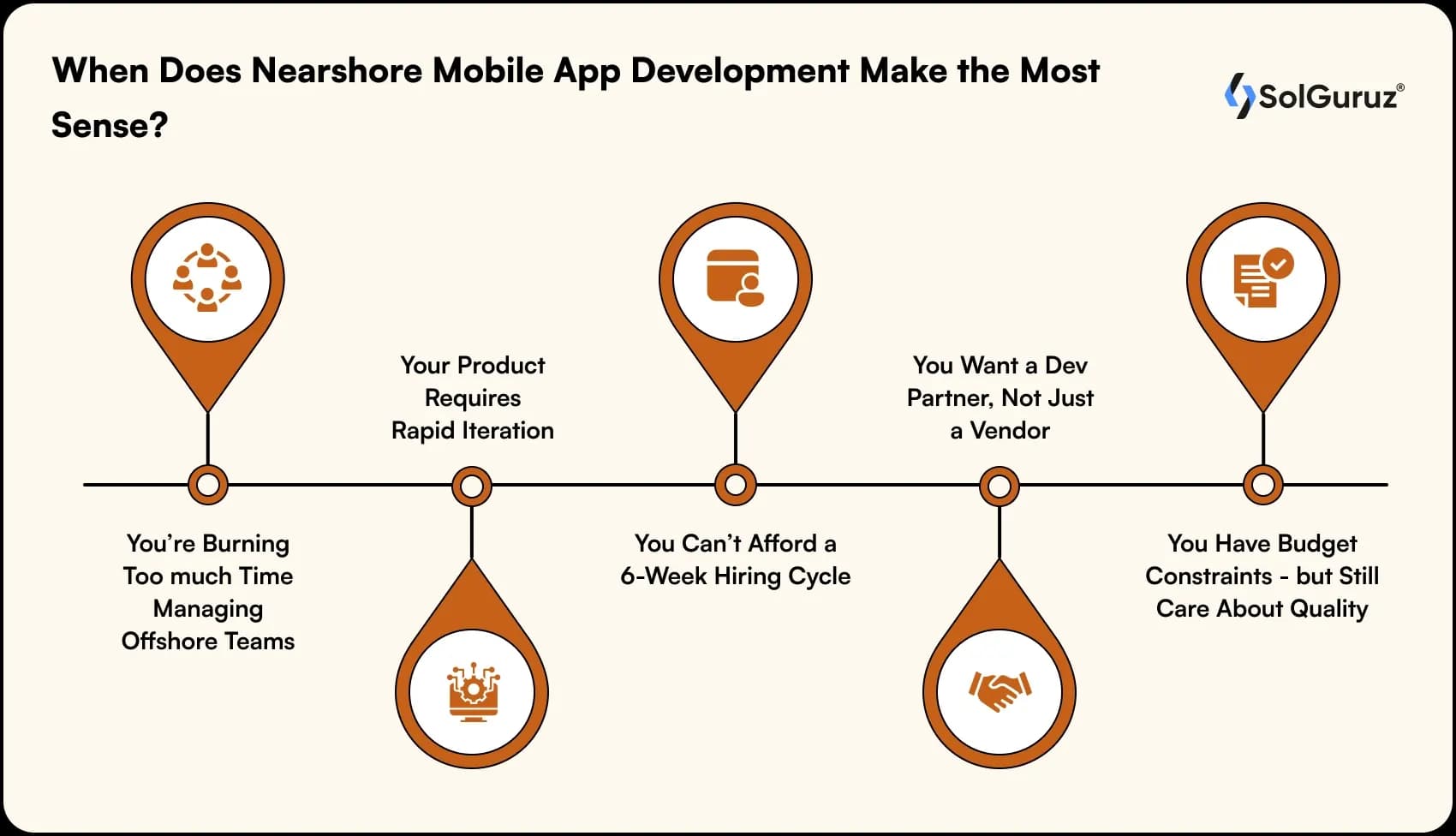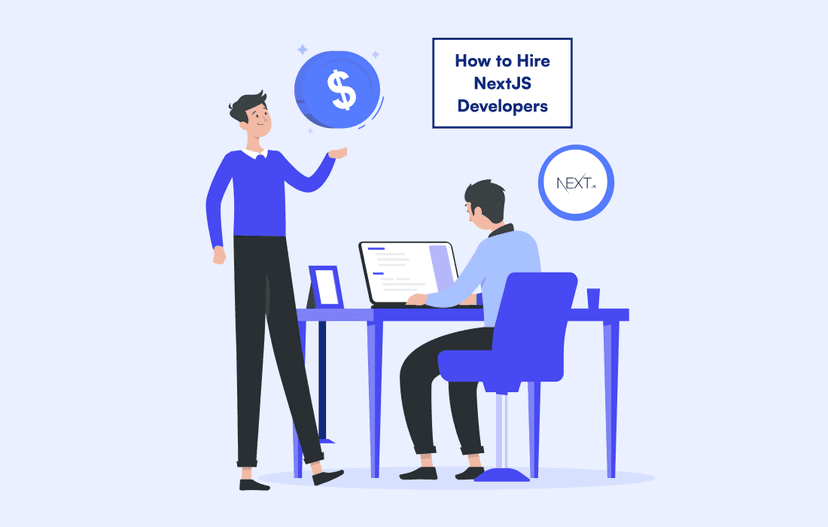What Is Nearshore Mobile App Development? Cost, Locations & Why It Works
This article breaks down nearshore mobile app development, what it is, why it works, where to hire, and how much it costs. We cover top nearshore regions, team structures, and tips for choosing the right partner so you can build faster, collaborate better, and scale without burning your budget.

Speed – Quality – Cost.
The three pillars of mobile app development are rarely in perfect balance.
You’re moving fast. And every wrong decision bombards you with unexpected delays.
That’s why more product teams are rethinking where they build, not just how they build.
Offshore used to be the go-to move. Lower costs, global talent.
But it came with tradeoffs: communication gaps, delayed feedback loops, and a frustrating lack of context.
Onshore means quality, but at a premium that rarely scales.
Nearshore mobile app development is emerging as the middle path that actually works.
In this guide, we’re breaking down what nearshoring really means, where the best teams are, what the true cost looks like, and how to do it right.
Table of Contents
What Is Nearshore Mobile App Development?
Nearshore mobile app development simply means that you are outsourcing your app development to teams in nearby countries.
It is usually done with those places that have at least 4 hours of timezone overlap. This is very much unlike offshore models, where your dev team might be 10–12 hours ahead.
Example: For a US-based company, nearshore regions such as Latin America (Mexico, Colombia, Argentina) or Canada offer significant overlap in working hours and strong English fluency.
What’s The Difference Between Nearshore, Offshore, and Onshore
| Model | Timezone Overlap | Avg Cost (USD/hr) | Communication Quality | Cultural Fit | Ideal For |
| Onshore | Full | $100–$150 | High | High | Regulated industries, early-stage PMF |
| Nearshore | 4–8 hours | $40–$75 | High | Moderate to High | Growth-stage startups, mid-market teams |
| Offshore | Minimal | $20–$45 | Medium | Moderate | Budget-constrained, low-priority projects |
Why Do Businesses Prefer Nearshore Mobile App Development?

Let’s be honest: outsourcing to companies has a reputation problem.
Too many teams have been let down by offshore vendors because of slow work and missed deadlines. That’s why nearshoring has become the default for teams who want to move fast and stay in control.
Here’s why it works:
1. Timezone Alignment = Real-Time Collaboration
This one’s non-negotiable. When your development team can hop on a 10 a.m. standup, clarify a feature mid-day, and ship by EOD, everything moves faster. No overnight lags. No 24-hour turnaround on simple questions.
Nearshoring gives you productive overlap enough to stay agile, without working odd hours.
2. Lower Cost, Higher Output
You’re not just saving 40–60% on hourly rates. You’re saving on rework, onboarding time, and the emotional cost of micromanagement.
Great nearshore teams operate like extensions of your in-house crew—often with tighter execution and leaner process overhead.
3. Cultural Fit That Reduces Friction
You won’t spend time over-explaining UX choices or rewriting Slack messages three times for clarity.
Nearshore teams tend to share more with the US kind of work culture, like clear ownership, proactive communication, and context awareness.
That means less back-and-forth and more time building.
4. Access to Top Talent (Without the Hiring Headaches)
The mobile app talent pool in LATAM is deep—and it’s getting better every year.
You’ll find engineers who’ve worked with U.S. startups, who understand agile product cycles, and who can contribute meaningfully beyond the code.
The best part? You skip the 6–8 weeks (or more) of recruiting, onboarding, and ramp-up.
5. Agility Without Losing Control
Nearshoring lets you scale fast—bring on a small squad to launch your MVP or expand into a full feature pod as usage grows.
And unlike many offshore setups, nearshore teams are easier to loop into your product rituals: roadmap reviews, customer feedback loops, even user testing.
But it’s not all flowers and rainbows. We have covered the pros and cons in detail for outsourcing in these two articles. Check them out:
- Pros & Cons of Outsourcing Web Development Services
- Pros & Cons for Outsourcing Mobile App Development
Most Preferred Nearshore Locations for Mobile App Development
When it comes to nearshoring, not all regions are created equal. The “where” matters—because talent availability, timezone overlap, English fluency, and even IP laws vary widely by country.
Here are the most preferred nearshore regions near the US:
1. 🇲🇽 Mexico
- Timezone: CST. Best for most US time zones since it has a perfect overlap
- Strengths: Good talent pool, cultural alignment, and English proficiency
- Popular hubs: Guadalajara, Mexico City, Monterrey
- Why it works: Mexico has become a top pick for agile mobile teams. They have fast onboarding, great communication, and easy travel if face time is needed.
2. 🇨🇴 Colombia
- Timezone: EST. It aligns well with East Coast startups
- Strengths: Skilled in Android/iOS, React Native, Flutter
- Popular hubs: Bogotá, Medellín
- Why it works: Colombia is investing heavily in tech education and has a growing number of dev startups that are inclined towards the US product culture.
3. 🇦🇷 Argentina
- Timezone: 1–2 hours ahead of EST
- Strengths: Highly skilled developers, often with startup experience
- Popular hubs: Buenos Aires, Córdoba
- Why it works: Argentina has a good stock of senior engineers fluent in English + a mature freelance culture that makes talent sourcing agile.
4. 🇧🇷 Brazil (emerging)
- Timezone: 1–3 hours ahead of EST
- Strengths: Big talent pool, though English varies
- Challenges: Bureaucracy, IP compliance can vary
- Why it’s promising: With massive investment in tech education and incubators, Brazil is becoming a serious contender for mobile dev, especially for companies willing to invest in long-term partnerships.
When Does Nearshore Mobile App Development Make the Most Sense?

To be very honest, nearshoring isn’t a one-size-fits-all solution. But there are clear signals that it’s the right move for your team:
-
You’re Burning Too Much Time Managing Offshore Teams
Timezone lag, late responses, and repeated clarifications are slowing you down. You’re losing velocity, not just hours.
-
Your Product Requires Rapid Iteration
Mobile apps with fast feedback loops, frequent updates, or UX-heavy features need tight collaboration. Nearshore teams help you iterate with them, not around them.
-
You Can’t Afford a 6-Week Hiring Cycle
In-house hiring is slow and expensive. With a vetted nearshore team, you can go from kickoff to first commit in under 10 days.
-
You Want a Dev Partner, Not Just a Vendor
You’re not just outsourcing tasks. You need someone who understands your roadmap, challenges specs, and builds with ownership.
-
You Have Budget Constraints – but Still Care About Quality
You can’t justify $120/hour rates but you also can’t afford poor execution. Nearshore offers that sweet spot between price and performance.
Nearshore Mobile App Development Cost Breakdown
Let’s get practical: how much should you actually budget for nearshore mobile app development?
You’ll often hear ranges like “$40 to $75 per hour,” which is technically true, but also unhelpfully broad.
What really matters is how that cost compares to the output, the roles involved, and the maturity of the team.
Here’s a quick comparison of nearshore costs with the US and India offshore equivalent:
| Role | Nearshore Cost | U.S. Equivalent | India Offshore |
| Junior Mobile Developer | $30 – $45/hr | $75 – $100/hr | $18 – $25/hr |
| Mid-Level Developer | $45 – $60/hr | $100 – $125/hr | $20 – $35/hr |
| Senior Mobile Engineer | $60 – $80/hr | $125 – $150/hr | $30 – $45/hr |
| UI/UX Designer | $40 – $60/hr | $90 – $120/hr | $18 – $30/hr |
| QA Engineer (Manual + Automation) | $35 – $55/hr | $80 – $110/hr | $15 – $28/hr |
| Project Manager / Scrum Master | $50 – $70/hr | $100 – $130/hr | $25 – $40/hr |
PS: The above rates are not freelance rates. This is what you’d pay to an agency-level partner with integrated processes, DevOps, and QA in place.
What if You Get Nearshore Type Work With Offshore Pricing?
The primary reason for opting for nearshore companies is that businesses prefer timezone alignment, quick communication, and agile development above all.
But let me tell you, there are companies like SolGuruz who can help you bridge that gap.
So what will you get?
- Experienced dev team that works fast
- Real-time feedback loops
- Quick communication
- Timezone alignment of working hours (yep, we have teams that work as per your timezone)
Sounds good? Let’s get on a quick call.
FAQs
1. How is nearshore different from offshore or onshore development?
Nearshore development gives you a balance between timezone overlap (4–6 hours), strong English fluency, and cultural alignment. Offshore is typically cheaper but comes with communication delays. Onshore provides quality but is often prohibitively expensive. Nearshore goes for the middle ground: efficiency without compromise.
2. How do I ensure quality when working with a nearshore team?
You need to look for partners with proven delivery frameworks. Check if they have agile sprints, QA automation, DevOps pipelines, sprint reviews, and transparent reporting. Start with a paid pilot. You can ask for case studies and talk to their past clients so that you can feel confident before committing.
3. What if I need to scale the team quickly?
That’s where nearshore shines. Most partners can ramp resources within 1–2 weeks compared to 1–2 months when hiring in-house. At SolGuruz, we can scale teams based on your sprint velocity or roadmap phase, without disrupting your build cycles.
4. Is nearshore development secure for IP and data compliance?
Yes. Many reputable nearshore firms operate under US-style contracts, with NDAs, IP transfer clauses, and data security policies. From your end, make sure that your vendor can walk you through their compliance protocols.
5. How quickly can I get started with a nearshore partner like SolGuruz?
With us? As fast as 10 business days. From discovery to onboarding, we’ll help you define the scope, align on sprint structure, and get your first commits rolling. We believe early momentum is key, and we’ve built our process to deliver it.
Build Smarter 🚀 – Not Just Cheaper
If you're looking for a team that understands your product, your speed, and your standards, let’s talk.

Strict NDA

Trusted by Startups & Enterprises Worldwide

Flexible Engagement Models

1 Week Risk-Free Trial
Give us a call now!

+1 (724) 577-7737


